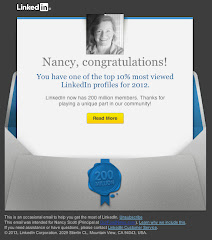I just watched Ed Gandia's three videos on "warm prospecting." Ed is the founder of the
International Freelancer's Academy, but the advice he offers here is terrific for anyone looking for business: PR professionals, direct marketers, and sales professionals can all use these tips.
Ed's three videos are each 15 to 20 minutes and packed with information. Sign up
here and watch them if you have time, but the videos will be taken down on December 11. (Note: Ed includes a full transcript of each video, so you can download those pdfs if you can't listen today).
If you're in a hurry for quick information, here are my notes.
Why Is Email Propecting So Effective (When Done Right)?
1. Less intrusive and more convenient than cold calling.
2. Better than phone messages, which can't be scanned quickly.
3. Prospects are far more responsive to a well delivered email.
4. With cold-calling, you get 3 to 5 seconds; email gives you 20 seconds.
5. It's easier to digest a marketing message in writing.
6. When the email is personal and targeted, it's very effective.
7. Propsecting with email helps you stay motivated.
8. Email prospecting is inexpensive.
9. Email prospecting is quick and immediate!
10. You can hand-pick the prospects you want to work with.
Here is what doesn't work.
1. Don't send an email blast to a list.
2. Don't send the same message to everybody.
3. Don't use email to market your newsletter.
Warm Email Prospecting Works When You ...
1. Handpick your list.
2. Customize your list.
3. Write an email like this:
Hi Randy,
I’ve been reading about your company in the Atlanta Business Chronicle and the work you’ve been doing at Emory
Hospital. And based on the work I’ve done with Acme Medical and XYZ International, I may be able to help you get "X" accomplished faster and cheaper.
Here’s a short article on how I’ve helped Acme
Medical: [URL goes here]. Would it make sense for us to chat briefly sometime in the next couple of weeks?
Regards,
[Your email signature]
1. Describe your ideal client profile.
- Get clear about the clients you are best suited to.
- No specialty needed.
2. Create a targeted list.
- Create a TARGETED list (identify organizations, identify specific individuals, find the email addresses for those individuals)
3. Establish a meaningful connection.
- You have to give every prospect a good reason to respond immediately
- Give the prospect a relevant reason to reach out to you.
4. Make a quick and relevant pitch -- 125 WORDS OR LESS.
- No small talk; no warming up the prospect.
5. Prepare for conversation.
- You need to be ready when the prospect calls you.
- Have some stock email to respond to a positive answer.
- Develop a set of talking points for the call.
6. Do smart follow-up
Remember:
- Warm Prospecting is a direct response strategy. MOST attempts will not get a response.
- Recommends sending a 2nd response after 2 weeks of no response.
How to Uncover and Communicate a Meaningful Connection with Your Prospect
The key strategy is to give prospects a meaningful bridge to connection
Three Ways to find Meaningful Connections
1. Use trigger events
- A big event or change in the organization's industry is a logical trigger event; for example, positive or negative financial announcements; new manager in the department you usually work with; layoffs, downsizing; finding prestigious new clients, etc.
- Trigger events create a certain level of pain or need that makes the organization more receptive to your needs.
- Scour the news for trigger events (industry or trade pubs, business pubs, news magus, etc.).
- Set up Google alerts for organizations already on your targeted list.
2. Mention one of your high profile clients or one of your accomplishments.
- It may make sense to throw out names that the prospect may recognize or even names they may not recognize.
- Leverage your successes. Mention an award you've recently accomplished, or a placement you made for a client.
3. Leverage a mutual connection and think of LinkedIn.
- Look at your personal or professional network.
- See if somebody will make an introduction for you.
- Use LinkedIn account to see if somebody in your immediate network knows your prospect
What About Subject Lines for Your Warm Prospecting Emails?
1. Use your subject line to allude to the meaningful connection you will talk about.
- Examples: Congrats on the Book Deal! or … I Helped B&B Foods Rebrand …
2. Keep subjects short -- 30 to 50 characters.
3. Show relevance in the subject, but don't give away too much information and don't "bait and switch."In the body of your short email, deliver on the subject line.
-- scrubbed by MarketingBrillo
 Visiting the Lawtons, I had a little revelation. How powerful the Internet is!
Visiting the Lawtons, I had a little revelation. How powerful the Internet is!


